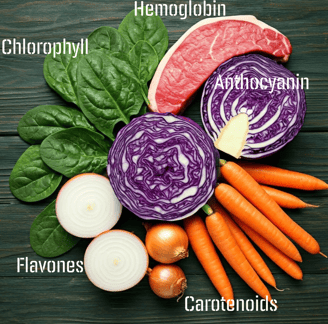Food Pigmentation
Content of Notes:
1. Introduction to Food Color
Pigmentation
2. Types of Food Color Pigments
Chlorophyll
Hemoglobin
Anthocyanin
Flavones
Carotenoids
Food Color Pigmentation
Food color pigmentation refers to the natural compounds in food that give it color. These pigments not only make food look more appealing but also have important roles in nutrition and health. Most natural pigments are phytonutrients, which provide antioxidant benefits, protect against UV light, and support overall health. Common types of food pigments include chlorophyll, anthocyanins, carotenoids, flavones, and hemoglobin. These pigments create the different colors we see in foods like green, red, purple, yellow, and orange.
These pigments are sensitive to things like heat, light, and pH, which can change their color and affect their nutritional value. Understanding how these pigments react to cooking and processing helps keep food both visually appealing and nutritious. Below is a simple guide to the main types of food pigments, how they react to heat, and some cooking tips to preserve them.
1. Chlorophyll
• Name of the Pigment: Chlorophyll
• What it Does: Chlorophyll is the green pigment in plants, essential for photosynthesis (how plants make energy from light). It’s also known for being a good antioxidant, helping detoxify the body, and promoting healthy skin.
• Food Examples:
Spinach, Kale, Broccoli, Green peas, Zucchini, Asparagus, Green beans, Cucumber, Kiwi, Matcha, Romaine lettuce, Swiss chard, Watercress, Brussel sprouts, Green bell peppers
• Heat Effect on Chlorophyll:
Chlorophyll is sensitive to heat. When cooked, its color changes from bright green to olive green because it loses magnesium, turning into a duller compound called pheophytin.
• Cooking Precaution:
To keep vegetables bright green, blanch them quickly in boiling water and then cool them in ice water (called shocking). Adding a bit of baking soda can also help, but it may change the taste and texture.
2. Hemoglobin
• Name of the Pigment: Hemoglobin
• What it Does: Hemoglobin is the red pigment in animal blood and is responsible for transporting oxygen. It gives red meat its color, which changes during cooking as the pigments oxidize (react with oxygen).
• Food Examples:
Beef, Lamb, Pork, Venison, Duck, Turkey (dark meat), Chicken (dark meat), Bison, Goat, Quail, Pigeon, Rabbit, Elk, Ostri ch, Wild boar
• Heat Effect on Hemoglobin:
As meat cooks, the hemoglobin turns from red to pink and eventually brown as the pigments oxidize. If overcooked, the meat becomes gray and tough due to excessive oxidation.
• Cooking Precaution:
Avoid overcooking meat to keep it tender and pink. Searing the meat at high heat can lock in the juices and keep the inside red. Use a meat thermometer to ensure it’s properly cooked without overdoing it.
3. Anthocyanin
• Name of the Pigment: Anthocyanin
• What it Does: Anthocyanins are pigments responsible for the red, purple, and blue colors in fruits and vegetables. They have strong antioxidant properties, providing benefits like reducing inflammation and protecting the heart.
• Food Examples:
Blueberries, Blackberries, Raspberries, Strawberries, Red cabbage, Eggplant (skin), Red grapes, Cherries, Plums, Purple sweet potatoes, Black currants, Purple carrots, Red onions, Elderberries, Red radishes
• Heat Effect on Anthocyanins:
Anthocyanins are sensitive to heat, pH, and light. They change color with the pH of the cooking environment. In acidic conditions (e.g., adding lemon juice), they turn redder, while in alkaline conditions, they become blue or green. Long exposure to heat can cause their color to fade.
• Cooking Precaution:
Cook these foods for a short time and avoid high heat. Adding a little acid like lemon juice can help keep the red-purple color. To preserve both the color and nutrients, minimize cooking time, especially for berries.
4. Flavones
• Name of the Pigment: Flavones
• What it Does: Flavones are pale yellow or white pigments found in certain foods. They are known for their antioxidant and anti-inflammatory benefits, helping to protect cells from damage.
• Food Examples:
Parsley, Celery, Yellow bell peppers, Chamomile, Hot peppers, Oregano, Thyme, White beans, Green bell peppers, Cilantro, Red chili peppers, Mint, Broccoli, Cauliflower, Fennel
• Heat Effect on Flavones:
Flavones are stable under heat but can break down if cooked for too long or at high temperatures. This can reduce their antioxidant properties.
• Cooking Precaution:
To keep flavones intact, cook these foods quickly or eat them raw. Add herbs like parsley or celery toward the end of cooking to maintain their nutrients.
5. Carotenoids
• Name of the Pigment: Carotenoids
Carotenoids are fat-soluble pigments that provide yellow, orange, and red colors to many fruits and vegetables. These pigments include beta-carotene, lycopene, lutein, and zeaxanthin, which are essential for vision, skin health, and immune function. Carotenoids are also precursors to vitamin A.
• Food Examples:
Carrots, Sweet potatoes, Butternut squash, Pumpkin, Mango, Papaya, Cantaloupe, Orange bell peppers, Tomatoes, Watermelon, Corn, Red peppers, Apricots, Tangerines, Yams
• Heat Effect on Carotenoids:
Carotenoids are generally heat-stable, and cooking can actually increase their bioavailability by breaking down cell walls, making it easier for the body to absorb them. However, prolonged heat exposure can cause slight degradation and loss of color intensity, especially in delicate fruits.
• Cooking Precaution:
Since carotenoids are fat-soluble, cooking them with a small amount of fat (such as olive oil) can enhance their absorption. Avoid overcooking or using excessive heat, which can degrade some of the carotenoid content. Steaming or lightly sautéing carotenoid-rich vegetables is ideal to preserve both their color and nutritional value.
Key Terms:
Food Pigmentation – Natural compounds responsible for color in foods, often with health benefits.
Chlorophyll – Green pigment in plants, essential for photosynthesis.
Hemoglobin – Red pigment in animal blood, responsible for oxygen transport.
Anthocyanins – Water-soluble pigments producing red, purple, and blue colors in fruits and vegetables.
Flavones – A type of flavonoid responsible for pale yellow or white colors in foods.
Carotenoids – Fat-soluble pigments providing yellow, orange, and red hues, including beta-carotene, lycopene, and lutein.
Photosynthesis – Process by which plants use chlorophyll to convert sunlight into chemical energy.
Oxidation – Chemical reaction causing color changes in food pigments like hemoglobin.
Heat Stability – The resistance of pigments to degradation when exposed to cooking temperatures.
Pheophytin – A dull olive-green pigment formed when chlorophyll is heated and loses its magnesium ion.
Bioavailability – The extent to which nutrients (like carotenoids) are absorbed and utilized by the body.
pH Sensitivity – Anthocyanins change color depending on the acidity or alkalinity of the environment.
Antioxidants – Compounds that prevent oxidative stress, often found in pigments like anthocyanins and carotenoids.
Cooking Precautions – Techniques like blanching, adding acid, and cooking with fat to preserve the color and nutrition of pigments.
Fat-Soluble – Refers to pigments like carotenoids, which are absorbed better when consumed with dietary fat.




BASICS OF FOOD PRODUCTION
FOOD PIGMENTATION








